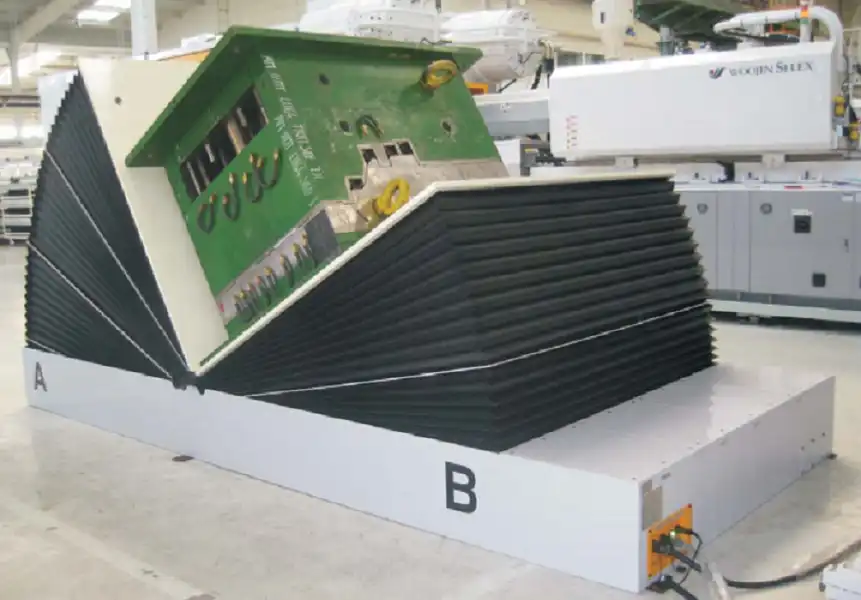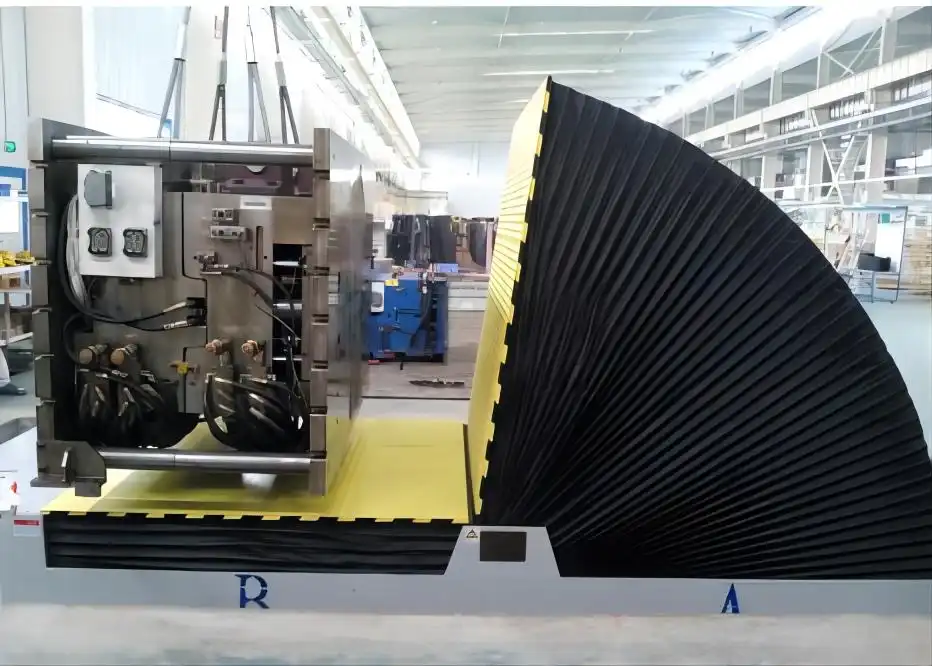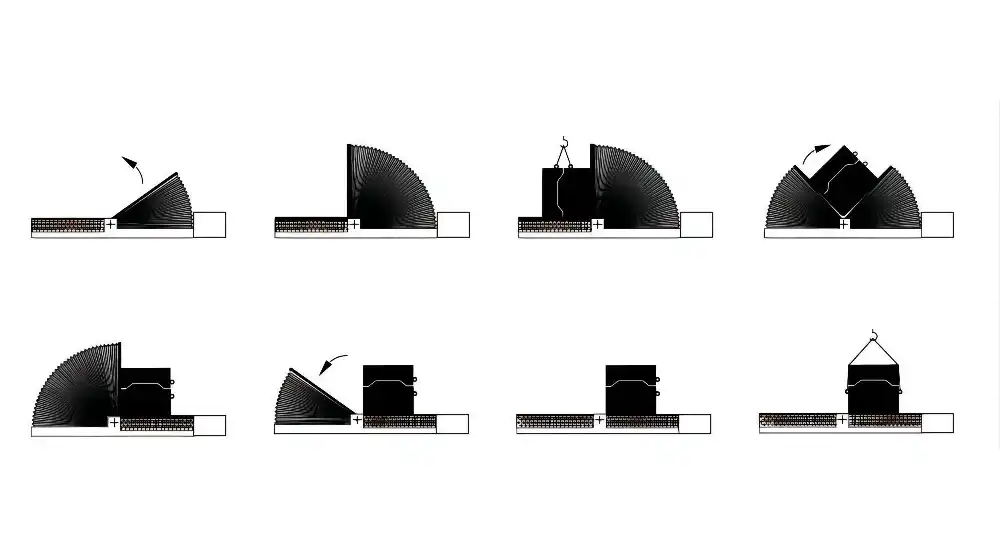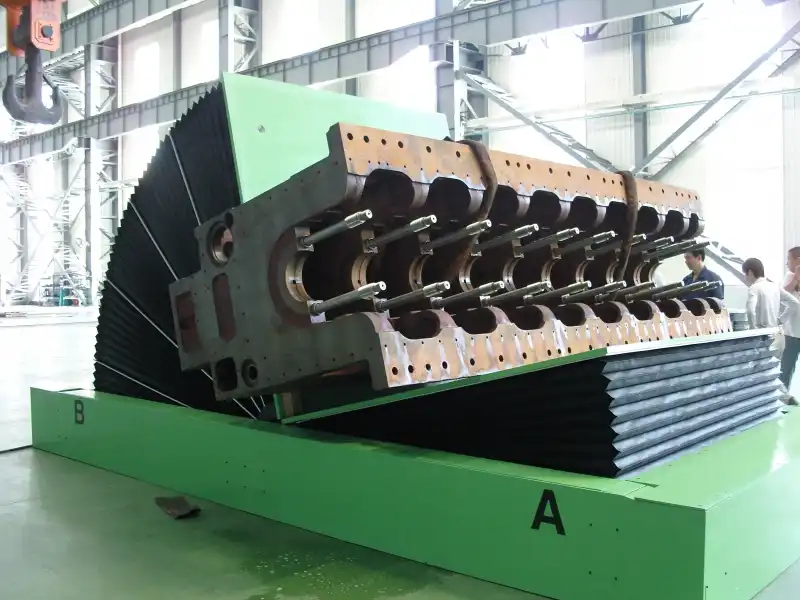When I visit factories, I see a common problem. Heavy molds, weighing several tons, are often turned using overhead cranes and slings. This process is slow. It is dangerous. And it creates a huge bottleneck in the production line. I have seen expensive molds get damaged from a slip. I have heard stories of near-miss accidents that could have been catastrophic. These issues are not just operational headaches; they are hidden costs that drain your profits and put your team at risk. So, you know you need a better solution, like an automatic mold upender. But how do you justify the investment to your board? Especially in a competitive and demanding market like Brazil, engineers need to prove the value with hard numbers.
Brazilian engineers evaluate the ROI on automatic mold upenders by calculating a combination of direct and indirect financial gains. They focus on four key areas: 1) direct labor and operational cost reductions from automating a manual process, 2) quantifiable financial savings from improved safety and accident prevention, 3) increased revenue from faster production cycles and greater uptime, and 4) lower Total Cost of Ownership (TCO) due to the machine's long-term reliability and reduced maintenance.

This calculation is more than a simple spreadsheet. It's a strategic analysis. My friends and clients in the Brazilian steel and manufacturing sectors are some of the most practical people I know. They have taught me that a true ROI evaluation looks at the entire picture. It’s not just about the machine's price tag. It's about how that machine transforms safety, speed, and stability on the factory floor. Let's break down their thought process, step by step. We will look at the real data points they use to make a confident investment decision.
What Are the Direct Cost Savings in the ROI Calculation?
You see an old crane and a team of workers, and you might think it's a "free" resource because you already own it. But is it really free? Every time that crane operates, it consumes a large amount of electricity. Every worker on that team has a salary. Every year, that crane needs expensive maintenance and new slings. These are direct costs, and they add up quickly. I once spoke with a plant manager in São Paulo who was shocked when we calculated his real cost for turning one mold. The number was much higher than he thought. An automatic mold upender is designed for one specific task, so it is incredibly efficient and replaces these hidden costs with a predictable, low operating cost.
The most immediate and tangible part of the ROI calculation for an automatic mold upender comes from direct cost savings. Brazilian engineers meticulously add up the daily expenses of the manual method, including the wages of multiple operators, the high energy consumption of a general-purpose crane, and the recurring costs of maintenance and consumable parts like slings. They then compare this total with the significantly lower operating cost of a single, efficient upender.

Deeper Dive into Direct Costs
When I started my own factory, I had to watch every penny. This taught me to see costs that are not always obvious. An engineer evaluating an upender does the same thing. They break down the costs into clear categories to build a strong business case.
Labor Cost Reduction
This is the easiest cost to calculate. A manual operation with a crane often needs at least two or three people: a certified crane operator and one or two riggers on the ground to manage the slings and the load. An automatic mold upender requires only one operator, who can manage the entire process from a safe distance with a simple control panel. The savings are clear.
| Metric | Manual Crane Method | Automatic Mold Upender |
|---|---|---|
| Personnel Required | 1 Crane Operator + 2 Riggers | 1 Machine Operator |
| Time per Operation | 15-20 minutes | 2-3 minutes |
| Total Labor Minutes | (3 people) * 15 min = 45 min | (1 person) * 2 min = 2 min |
| Risk of Error | High | Very Low |
Let's say the average loaded labor cost in a Brazilian industrial zone is $15 USD per hour. For a 15-minute operation, the manual method costs 3 people * (15/60 hours) * $15/hour = $11.25. The upender costs 1 person * (2/60 hours) * $15/hour = $0.50. If you turn molds 10 times a day, that's over $100 per day in direct labor savings alone.
Maintenance and Repair Avoidance
Overhead cranes are complex machines. They need regular inspections, lubrication, cable checks, and certifications. Slings and chains wear out and must be replaced to ensure safety. This is a constant maintenance budget line item. More importantly, using a crane for a task it wasn't designed for—tilting an unbalanced load—puts immense stress on the equipment and the mold itself. I had a client whose team dropped a die-casting mold worth over $80,000. The cost of repairing that mold was more than half the price of a new upender. An automatic upender protects your expensive tooling. This "cost avoidance" is a critical part of the ROI.
Energy Consumption
An overhead crane motor is powerful because it needs to lift heavy loads high into the air. This consumes a lot of electricity. A mold upender uses a much smaller, more efficient hydraulic or electromechanical system. It only needs to perform one smooth, controlled tilting motion. The energy used per cycle is a fraction of what a crane uses. For a large steel plant or foundry facing volatile energy prices in Brazil, this difference in energy consumption can translate to thousands of dollars in savings each year.
How is Increased Safety Quantified as a Financial Gain?
An accident on the factory floor is every manager's worst nightmare. The human cost is, of course, the most important thing. But the financial cost is also devastating. Production stops immediately. An investigation begins. There are direct medical and compensation costs. And then there are the indirect costs that linger for months: higher insurance premiums, damage to worker morale, and potential fines from regulatory bodies. I believe that a safe factory is a profitable factory. Brazilian engineers understand this too. They don't see safety as an expense. They see it as an investment with a measurable return, and they know how to put a number on it.
Engineers in Brazil quantify the financial gain from increased safety by calculating the total potential cost of a workplace accident and treating its prevention as a direct return. This calculation includes the high costs of worker compensation claims, lost production during shutdowns, steep government fines for non-compliance with standards like NR-12, and the predictable increase in annual insurance premiums that follows any serious incident. Avoiding these massive, unpredictable costs provides a powerful financial justification for the upender.

Deeper Dive into Safety ROI
Turning safety into a number on an ROI sheet seems difficult, but it's a standard practice in risk management. It involves looking at potential negative events and assigning a cost to them. The investment in an upender dramatically reduces the probability of these events, so the "avoided cost" becomes a key part of the return.
The Direct and Indirect Cost of an Incident
A single accident can have a ripple effect on your finances. The engineers I work with in Brazil build a model that looks like this:
| Cost Category | Description | Estimated Potential Cost (Example) |
|---|---|---|
| Direct Costs | Medical treatment, worker compensation payments, equipment repair. | $10,000 - $100,000+ |
| Indirect Costs | Lost production time, investigation & administrative time, hiring temporary staff. | $20,000 - $500,000+ |
| Regulatory Fines | Penalties for safety violations, especially under Brazil's strict NR-12 standard. | Can reach millions of BRL. |
| Insurance Hikes | Increased annual insurance premiums for several years following an incident. | 20-50% increase on premium. |
Even a minor incident can easily cost a company over $50,000 when all factors are considered. A major one can be financially crippling. By investing in an upender that virtually eliminates the primary risk, a company is essentially buying insurance against these costs.
The NR-12 Compliance Factor
Brazil's Norma Regulamentadora 12 (NR-12) is one of the most comprehensive machine safety standards in the world. It governs every aspect of machine safety, from electrical panels to physical guards and emergency stops. Using an old crane and slings for turning molds is a grey area that attracts negative attention from inspectors. A non-compliant operation can lead to huge fines and even factory shutdowns. A modern, certified automatic mold upender is designed from the ground up to be NR-12 compliant. Therefore, its cost is not just for the machine; it's for the peace of mind that comes with guaranteed compliance. This is not just avoiding a fine; it is protecting the company's license to operate.
Improving Worker Morale and Retention
While harder to quantify, a safe environment is crucial for a productive workforce. When workers see a company investing in their safety, it builds trust and loyalty. It reduces stress and allows them to focus on their jobs. In a tight labor market for skilled workers, a reputation for being a safe employer is a competitive advantage. It helps attract and retain the best talent, reducing hiring and training costs over the long term.
How Does Operational Efficiency Translate into Higher Revenue?
A production line is like a chain; it is only as strong as its weakest link. In many plants, the process of changing a mold is the weakest link. It can stop the entire line for 30 minutes, an hour, or even longer. While the line is down, you are not making product. You are not generating revenue. All you are doing is paying for idle workers and equipment. I visited a client in the automotive sector who was struggling with this. They could produce parts quickly, but their slow mold changes meant they couldn't meet the demand from their customers. By speeding up just that one process, they didn't just cut costs—they unlocked a whole new level of production capacity and profit.
Brazilian engineers translate operational efficiency into revenue by calculating the financial value of increased uptime and throughput. They measure the time saved on each mold change, multiply it by the number of changes per shift, and determine how many additional production units can be made in that recovered time. This increase in sellable product, achieved without adding shifts or machinery, flows directly to the company's top-line revenue and bottom-line profit.

Deeper Dive into Efficiency Gains
Connecting a piece of handling equipment to revenue generation is the most powerful part of any ROI argument. It shifts the conversation from "How much does it cost?" to "How much more can it make us?" Here is how a practical engineer builds that case.
Calculating the Value of Uptime
The first step is a simple time study. You compare the old way with the new way.
- Manual Method: 30 minutes per mold change.
- Automatic Upender: 5 minutes per mold change.
- Time Saved per Change: 25 minutes.
If a line performs 6 mold changes per day, the total time saved is 25 minutes/change * 6 changes = 150 minutes, or 2.5 hours of extra production time every single day. The next step is to attach a value to that time. If the production line generates $2,000 in revenue per hour, those 2.5 hours are worth an additional $5,000 in revenue per day.
From Throughput to Profit
Increased revenue is great, but CEOs want to see profit. Because the factory's fixed costs (rent, administration, etc.) are already covered, the profit margin on these additional units is often much higher than average. Let’s create a simple table to show the impact.
| Metric | Before Upender | After Upender | Daily Improvement |
|---|---|---|---|
| Mold Changes / Day | 6 | 6 | 0 |
| Time per Change | 30 min | 5 min | 25 min |
| Total Changeover Time | 180 min (3 hrs) | 30 min (0.5 hrs) | 2.5 hrs saved |
| Available Prod. Time (8hr shift) | 5 hrs | 7.5 hrs | +50% |
| Units Produced (@100/hr) | 500 | 750 | +250 units |
| Revenue (@$20/unit) | $10,000 | $15,000 | +$5,000 |
This analysis shows that the machine isn't just a cost center; it's a revenue generator. For a CEO like Javier Morales, who wants to increase capacity utilization to 95%, this kind of data is exactly what he needs to see. It directly supports his primary strategic goals.
Unlocking Agility and New Markets
Speed also creates flexibility. When mold changes are fast, it becomes profitable to accept smaller, more frequent orders. This opens up new markets, like just-in-time (JIT) delivery for the automotive or appliance industries. A factory that was once slow and could only handle large, planned production runs can now become agile and responsive to customer needs. This strategic advantage is difficult to put a price on, but it is incredibly valuable in today's fast-moving economy.
What Role Does Long-Term Reliability Play in the Final Decision?
When I first started my business, I was tempted to buy the cheapest equipment I could find. I quickly learned a hard lesson: a cheap machine that breaks down is the most expensive machine you can own. The initial saving is quickly lost to downtime, expensive emergency repairs, and the stress of an unreliable production line. A smart engineer, especially one in a demanding environment like a Brazilian steel mill, knows this. They are not just buying a machine for today. They are investing in a solution that needs to work reliably for the next 15 to 20 years. They are looking for a partner, not just a supplier.
In their final ROI evaluation, Brazilian engineers heavily weigh long-term reliability by analyzing the Total Cost of Ownership (TCO). This goes far beyond the initial purchase price. It includes projected costs for maintenance, energy consumption, spare parts, and, most importantly, the massive potential cost of unscheduled downtime over the machine's entire service life. A durable, well-supported machine with a lower TCO is always seen as a better investment than a cheaper, less reliable alternative.

Deeper Dive into Reliability and TCO
Evaluating reliability requires a forward-looking perspective. It's about asking the right questions before you buy, to avoid problems later. A good engineer will investigate these areas thoroughly.
The Total Cost of Ownership (TCO) Formula
TCO is a simple concept that provides a complete picture of an investment. The basic formula is:
TCO = Initial Price + Lifetime Operating Costs + Lifetime Maintenance Costs - Salvage Value
A lower initial price can be very attractive, but if the operating and maintenance costs are high, the TCO will be much greater. For example, a machine built with lower-quality components might be 20% cheaper upfront. But it might require twice the maintenance and have a major breakdown every two years. The cost of that downtime will quickly erase any initial savings.
Here is how a comparison might look:
| Cost Factor | Low-Cost Supplier | High-Quality Partner (SHJLPACK) |
|---|---|---|
| Initial Price | $80,000 | $100,000 |
| Annual Maintenance | $5,000 | $1,500 |
| Downtime Cost (10yr) | $150,000 (3 major failures) | $10,000 (minor issues) |
| 10-Year TCO | $280,000 | $125,000 |
This is why experienced leaders look past the sticker price. They are making a long-term decision.
The Importance of a Strategic Partner
Reliability is not just about the machine's steel and motors. It's about the company that stands behind it. At SHJLPACK, we don't just sell machines; we provide a total solution. This is what a strategic partner does. When a Brazilian engineer evaluates a supplier, they ask:
- Do you provide local support or have local partners?
- How quickly can I get spare parts? Are they standard components I can buy locally?
- Do you offer training for my operators and maintenance team?
- Will you be there to help me five or ten years from now?
The answers to these questions are a critical part of the investment. A reliable partner reduces risk.
Quality Components Matter
I am an engineer by training. I know that the quality of a machine is determined by the quality of its parts. When we build our upenders, we use reinforced steel frames, motors from world-class brands like SEW or Siemens, and robust, easy-to-use control systems. This costs more initially, but it ensures the machine runs smoothly for decades. A savvy engineer will check the bill of materials. They will look at the brand names of the motors, the hydraulics, and the electronics. They know that quality components are the best guarantee of a long and productive service life.
Conclusion
Evaluating a mold upender's ROI goes beyond price. It's a strategic calculation of safety, efficiency, and long-term reliability. A smart investment quickly pays for itself.





